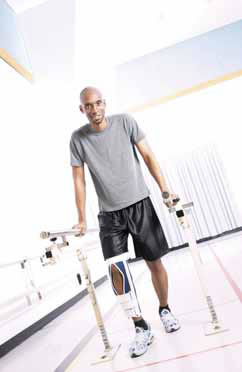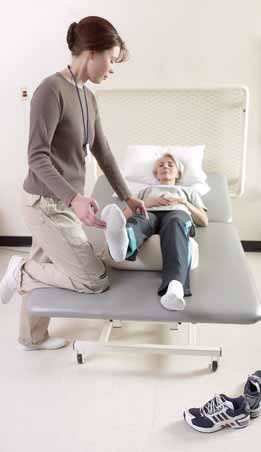Volume 19 · Issue 3 · May/June 2009 | Download PDF
by Scott Waite, MPT
How Can It Help Your Recovery?

Whatever the reason, if an amputee goes a reasonably long period without a prosthesis with the intention of using one in the future, certain precautions should be taken to enable proper functioning of the limb once the prosthesis is used.
In fact, even if amputees decide never to use a prosthesis, appropriate physical therapy is very important for their overall physical well-being. It can help them maintain and improve their circulation, skin health, strength and endurance, and it can help them decrease their risk of developing contractures (shortened muscles or tendons).
Through proper care, physical therapists can play a vital role in helping patients achieve their desired goals. Unfortunately, there are a limited number of physical therapists around the country who specialize in the full rehabilitation of amputee patients. It’s in patients’ best interest, however, to try to find one in their area. It is ultimately the patient’s responsibility to research and find the right therapist. Talking with your physician, calling local hospitals, or visiting therapy clinics will help you find the rehabilitation clinic that best suits your needs.
The goal of physical therapists is to provide the best care for their patients and to help them return to their previous level of function without causing any harm. Unfortunately, when physical therapists first see patients who have not had proper training before receiving their prosthesis, it’s highly likely that these patients will have increased physical limitations as a result.
An amputation is a traumatic event to the body, and recovery time varies from person to person. When patients have an appropriate amount of physical therapy, their physical therapist may have the opportunity to see them more often than any other medical professional and should be able to monitor their residual limb and incision area. Occasionally, a residual limb can take longer than normal to heal, become infected, or have undesirable skin pressure problems that could be either alleviated or controlled with such professional observation.

Further compression may, therefore, be required; the bandage may have to be wrapped more tightly or a smaller shrinker may be needed. The person’s physical therapist should check the condition of the limb for proper shaping.
Part of the healing process should involve residual-limb massage to assist in desensitizing and toughening up the limb in preparation for using a prosthesis. Different types of massage are needed, depending on the healing stage of the limb. A physical therapist can determine which type of massage is appropriate at the time and teach the patient the proper technique.
Residual-limb tightening and even contractures can easily occur due to decreased use of the limb and constant static limb positioning. In fact, constant static positioning of a person’s residual limb with minimal activity is probably the most common reason contractures are so prevalent in amputees. A general definition of a contracture is skin, fascia (connective tissue), muscles, tendons or joints that prevent normal movement of the related tissue or joints, such as when a knee or elbow joint is unable to be straightened completely.
Instruction regarding proper residual-limb positioning, stretching, and range-of-motion exercises is very important in decreasing the risk of contractures. Education in ways to prevent contractures is much easier and much more effective than trying to increase joint motion after tightening or a contracture has occurred. Although a prosthetist can make accommodations in the alignment of the prosthesis to help problems primarily involving hip and knee contractures, there will still usually be limitations once a problem has occurred. In addition, proper body mechanics will tend to be more difficult to achieve.
For any extremity to function properly, it must have a certain amount of motion in various directions. New amputees should be instructed in the necessary movements required by their residual limb and other pertinent joints. This will improve circulation, increase efficiency, and ultimately enable proper prosthesis use. Because prosthetic devices are designed to be very functional and are primarily based on “normal” body movements, it is important to keep or improve limb motion. Measuring limb motions can help in determining deficiencies, which physical therapists can then focus on to improve.
If amputees are to regain as much functional independence as possible, the residual limb must be as strong as possible to assist with prosthesis control. In my experience with prosthetic training involving upper or lower limbs, I’ve observed that patients have a difficult time using their residual limb properly. Early intervention to “wake up” an amputee’s residual limb with strengthening, neuromuscular reeducation, and stabilization exercises is critical for establishing the residual limb as a functional part of his or her body. For example, people with an above-knee amputation sometimes have difficulty establishing the functional mobility they need to use their prosthesis to its full capability. Gaining control of the residual limb through appropriate strengthening can determine how well they are able to use their prosthesis. Depending on the area of the amputation, certain muscle groups, such as hip extensors, quads, hamstrings, gluteals, abdominals, triceps, biceps, and rotator cuff muscles, are important for increasing strength, especially in preparation for prosthesis use.
Getting appropriate physical therapy from the right therapist at the right time and in the right amount can help you avoid all of these problems. When it comes to physical therapy, an ounce of prevention is certainly worth a pound of cure.
For More Information
“Stretches to Help Maintain or Improve Limb Function”
https://www.amputee-coalition.org/resources/stretches-to-help-maintain/
 About the Author
About the Author
Scott Waite, MPT, is the director of Physical Therapy Services for Fourroux Orthotics & Prosthetics. Waite specializes in prosthetic gait training and idiopathic scoliosis bracing. He also consults patients with recent amputations. Waite received his Bachelor’s Degree in Biology and his Master’s Degree in Physical Therapy. He has been treating people with amputations for the last 8 years.



 About the Author
About the Author